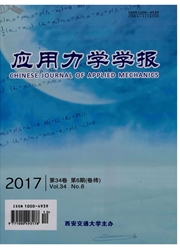

 中文摘要:
中文摘要:
这篇论文通过由电磁石层,永久磁铁层和粘弹性的抑制层组成的抑制的电磁的抑制的层(EMCLD ) 调查横梁的颤动控制。当电磁石的卷与合适的控制策略被触电时,电磁石能施加对结构的变丑的方向相反的磁性的力量以便结构的颤动被稀释。一个数学模型基于相等的当前的方法被开发计算 EMCLD 生产的电磁的控制力量。系统的管理方程用哈密尔顿的原则被获得然后与假设模式的方法减少了。一根伸臂横梁的颤动控制上的模拟在速度下面被进行表明 EMCLD 的精力驱散能力的比例的反馈,和有一样的参数的横梁系统被试验。实验和模拟的结果被比较,结果证明 EMCLD 是为压制形式的颤动的一个有效工具。结果也显示横梁系统为更大的控制电流有更好的控制性能。在这篇论文介绍的 EMCLD 方法为结构的颤动控制提供一个适用、有效的工具。
 英文摘要:
英文摘要:
This paper investigates vibration control of beam through electro-magnetic constrained layer damping (EMCLD) which consists of electromagnet layer, permanent magnet layer and viscoelastic damping layer. When the coil of the electromagnet is electrified with proper control strategy, the electromagnet can exert magnetic force opposite to the direction of structural deformation so that the structural vibration is attenuated. A mathematical model is developed based on the equivalent current method to calculate the electromagnetic control force produced by EMCLD. The governing equations of the system are obtained using Hamilton's Principle and then reduced with the assumed-mode method. A simulation on vibration control of a cantilever beam is conducted under the velocity proportional feedback to demonstrate the energy dissipation capability of EMCLD, and the beam system with the same parameter is experimented. The results of experiment and simulation are compared and the results show that the EMCLD is an effective means for suppressing modal vibration. The results also indicate that the beam system has better control performance for larger control current. The EMCLD method presented in this paper provides an applicable and efficient tool for the vibration control of structures.
 同期刊论文项目
同期刊论文项目
 同项目期刊论文
同项目期刊论文
 期刊信息
期刊信息
